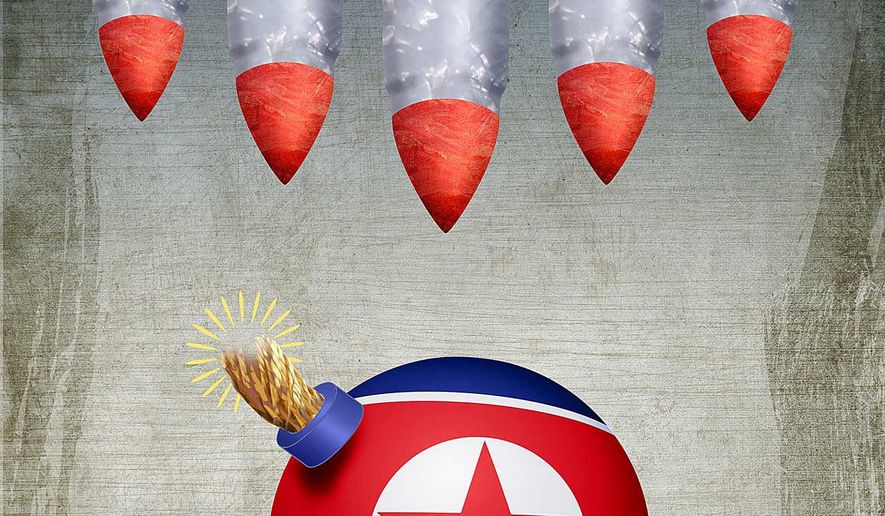OPINION:
If one consults the great strategists of the human experience such as Karl Von Clausewitz, Sun Tzu, or B.H. Liddell Hart the goal of strategy never changes: it is the application of power in order to attain a clear objective, which in the case for grand strategy could be multi-generational.
The United States has lacked a clear grand strategy regarding North Korea since 1953, and the current crises illustrate this exponentially. It is clear that the West, the United States, in particular, have multitudes of “Korea experts” who focus on very specific issues. Some of these experts focus on human rights, others on economic conditions, espionage, missiles and nuclear weapons. However, rather than becoming enveloped in the black hole of the cause celebre of the day, it is worth considering consulting strategy.
What is our strategy for North Korea? This is a meaningless question without answering what our clear objective is. If our objective is merely to retard the growth of the communist regime’s nuclear and missile capability, this might for a short time, be achieved by a new round of negotiations, greater pressure from China, and additional sanctions. We will eventually wake up one day to a fully nuclearized Korean peninsula, but we will have assuaged our guilt long enough to get through two or three of presidential administrations.
If however there is a real grand strategy then the only objective is the elimination of the North Korean regime and ultimate reunification with the South. If this is the objective, then unlike the poorly conceived Iran deal, there must be the linkages that many of our diplomats and subject matter experts dread. In other words, there can be no strategy that addresses the North Korean issue unless missile technology and nuclear arms are on an equal footing with human rights atrocities, economic privation, state-sponsored terrorism, narcotic trafficking, cybercrimes, counterfeiting, and arms proliferation.
This comprehensive approach leads only to one conclusion: the communist-red dynasty of the Kim family and its supporters must be ended. To achieve it, one must involve a methodical approach that integrates diplomacy, military precision, covert operations, sanctions, and a clear understanding that removal of the dynasty is merely one of the beginning acts (though not the first) in a drama that will ensure the least American casualties and burden as well as the health and transition for the Korean people.
Although some analysts have speculated on the existence and content of OPLAN 5029, a plan developed to deal with the extinction of the North Korean regime, the basic conceptional outline of any such a strategy would be based on the following parameters: First, critical allies, not a grand coalition, would be brought to make common cause to remove the Kim regime. The first use of military force would need to be massive: The attack must utilize stealth technology and cruise missile military platforms via preemption to destroy counterforce North Korean weaponry, command and control centers and WMD sites while similar attacks are occurring via covert (cyber and kinetic) operations.
The focus will quickly be on the Kim regime and its supporters. China will be assured that no western forces will permanently base themselves north of the 38th parallel but that the annihilation of the regime is non-negotiable. Following the attack, allied forces must quickly use specialized units to seize and liberate the concentration camps to avoid the mass murder that may follow any sudden collapse. These are camps whose very existence mocks the very existence of organizations such as the United Nations who have done nothing to stop an atrocity that many thought died with the Nazis, Soviets and Khmer Rouge.
Once the initial fighting has ceased, law, order, basic services, food and medical care which was already prepositioned in advance would deploy rapidly. The allied forces should force the hand of the United Nations to engage in something of use, and this could become their single most important activity in the 21st century. The North Korean population is around 25 million; military analysts assume that such a population will require an occupation force of 500,000 that will transition to peacemaking and stabilization.
Although the bulk of this can come from South Korea, there must be healthy contributions from countries such as the United States, Australia, Great Britain and possibly other NATO allies. Asian nations outside of Korea should be avoided for this particular task. The issue of North Korean refugees is not a simple or easy one, but the quicker stabilization can be brought to bear, the quicker this problem can be handled.
China will play a key role here, and the international community will need to assist them in this task. Ultimately, North Korea will evaporate as did East Germany and slowly be integrated into the Republic of Korea, though the process will make the German experience look easy. Throughout this process, counter-insurgency, PSYOP, counter-terrorism will be significant.
American leadership will be critical, and the president should make it clear to the American people that just as this was the only way to ultimately prevent the vaporization of San Francisco and Milwaukee, there is no quick exit. We have been there for 64 years enforcing an unworkable status quo; we can be there for a few decades more to bring an end to the worst regime on earth and solve our national security problem at the same time.
The issue must be taken out of the hands of technocrats or those who view the idea of diplomacy as more important than the objective. North Korea requires strategists, who like President Reagan knew that the only solution to the Soviet problem was the ending of the Soviet regime. The existence of the Kim regime and its actions is inimical to the security and values of the United States and is an abomination against both God and man.
• Lamont Colucci is a national security fellow at the American Foreign Policy Council.




Please read our comment policy before commenting.